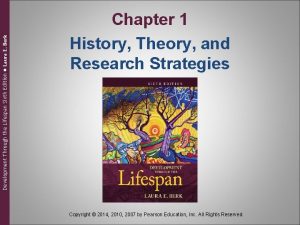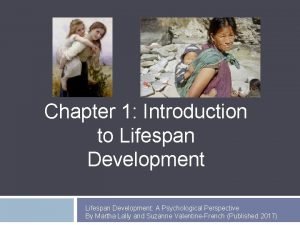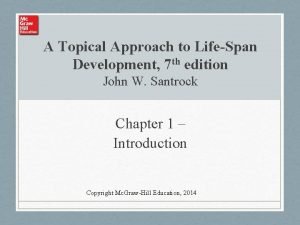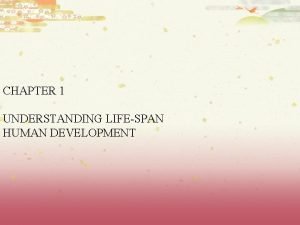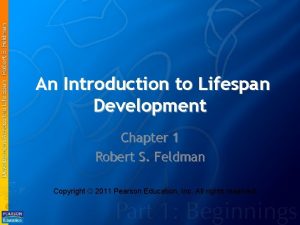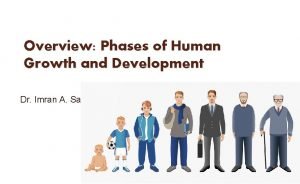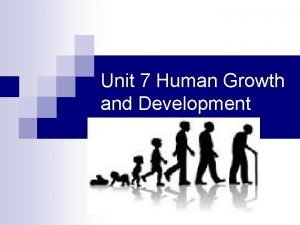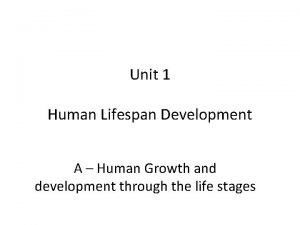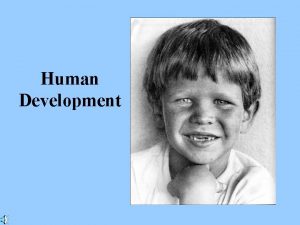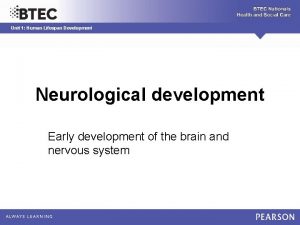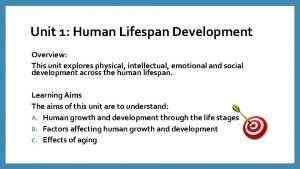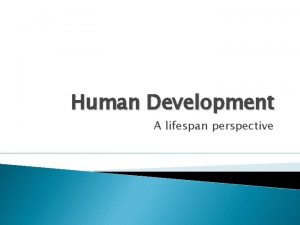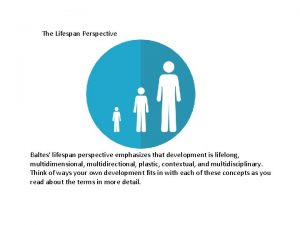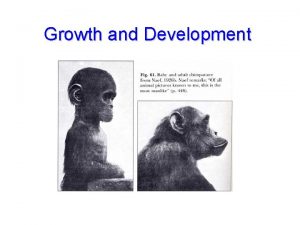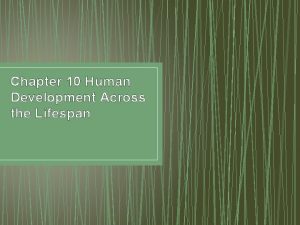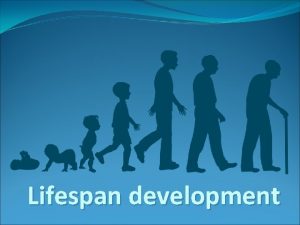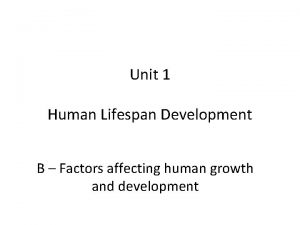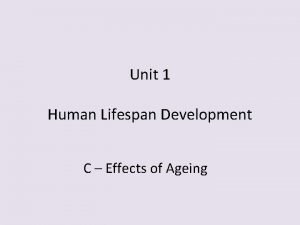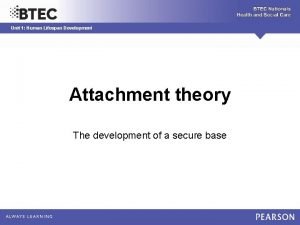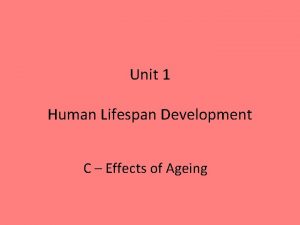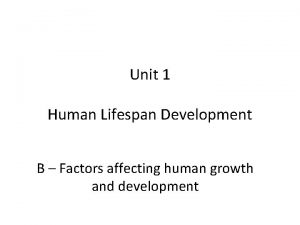Unit 1 Human Lifespan Development A Human Growth



























- Slides: 27

Unit 1 Human Lifespan Development A – Human Growth and development through the life stages

A. Human Growth and Development through life stages • A 1 – Physical development across the life stages • A 2 – Intellectual development across the life stages • A 3 – Emotional development across the life stages • A 4 – Social development across the life stages

A 3 – Emotional development across the life stages • Attachment to care-giver in infancy and early childhood – Theories of attachment, to include types of attachment and distributions to attachment • The development and importance of self-concept – Definitions and factors involved in the development of a positive or negative self esteem – Definitions and factors involved in the development of a positive or negative self image

Emotional Development • Emotional Development is the way an individual begins to feel about and value themselves and other people. • This forms the basis of emotional literacy and empathy. • Emotional development begins with attachments which an infant forms to their main caregiver. • If a child forms a strong attachment to their main caregiver, it can help to ensure a positive self-image and good self-esteem.

Emotional Development Key Terms • Emotional Literacy – the ability to recognise, understand appropriately express emotions. Emotional literacy is essential forming positive social relationships • Empathy – the ability to identify with or understand another’s situation or feelings ‘walking a mile in someone else’s shoes • Attachment – a strong emotional connection between a child and caregiver. • Self-image – the way an individual sees themselves, their mental image of themselves • Self-esteem – how a person feels about themselves, self-worth or pride.

Emotional Development Key features of emotional development Infants (0 -2 years) Bowlby argued that infants have an inbuilt need to form an attachment with a carer. The quality of this attachment may affect emotional development for the rest of the child’s life. Ainsworth and Marris both argue that the quality of early attachment influences the assumptions we make about our self and others. Infants who are securely attached will grow up with emotional resources needed to cope with uncertainty in life. Infants who are insecurely attached may have a reduced ability to cope with stress and major life events.

Emotional Development Key features of emotional development Early Childhood (3 -8 years) Understanding self and others Children use their imagination to begin to understand the social roles that other people play. Children begin to imagine a ‘me’ , and idea of self or self-concept. Relationships with other family members may influence whether a child feels valued or has a sense of self-worth. The way a child gest on with teachers and friends may influence their self-confidence. The child might develop a permanent sense of confidence or a sense of failure and inferiority

Emotional Development Key features of emotional development Adolesence (9 -18 years) Identity During adolescence, this sense of self continues to develop. An adolescent needs to develop a secure self-concept. A person needs a clear understanding of identity in order to feel secure when working with other people or in order to make a living sexual attachment. This may be a stressful time as self-esteem may depends on developing an identity.

Emotional Development Key features of emotional development Early and middle adulthood Intimacy In adulthood, an individual’s self-esteem is influenced by lifestyle such as their job or marital status. Self-image is affected by personal appearance and how others see you. Individuals need to learn to cope with emotional attachment to a sexual partner This may involve not being too self-centred or defensive and not becoming emotionally isolated.

Emotional Development Key features of emotional development Later Adulthood (65+ years) Making sense of your life Older people need a secure sense of self to enable them to cope with the physical changes associated with ageing and death. People who fail to make sense of their lives might experiences emotional despair.

Emotional Development Attachment to caregivers • A secure attachment to a main caregiver means that a child will feel happy, secure, loved and confident and have a sense of belonging. It gives them a secure base from which to explore the world around them. • It is important that parents ensure that children have the physical, mental and emotional nourishment to develop healthily • Secure attachments in childhood lead to happier and healthier attachments with others in the future.

Emotional Development Attachment to caregivers • IF there is a lack of a healthy attachment, then a mistrust of caregivers or adults in authority could develop. • Insecure attachments can lead to behavioural issues, a lack of ability to receive affection or manipulative behaviour. Children may not develop the secure base necessary to cope with life events.

Emotional Development Theories of Attachment - BOWLBY • John Bowlby refers to attachment as a deep and enduring emotional bond that connects a child to their primary caregiver. • His theory originated in the 1930’s while he worked as a child psychiatrist treating many emotionally disturbed children. • He linked the importance of social, emotional and cognitive development to the relationship that the child had with their mother. https: //www. youtube. com/watch? v=-Qi 7 tx. H 1 Kz. Y https: //www. simplypsychology. org/attachment. html https: //www. learning-theories. com/attachment-theory-bowlby. html

Emotional Development Theories of Attachment - BOWLBY • Bowlby observed that children experienced separation anxiety (fear and apprehension infants experienced when separated from their primary caregiver). Question: What could cause separation anxiety? Question: Do you think this happens for all babies?

Emotional Development Theories of Attachment - BOWLBY • Critics argued that Bowlby oversimplified his theory. • Rutter argues that maternal deprivation (being deprived of a caregiver to whom an attachment already exists) may not result in long-term problems. Privation (being deprived of the opportunity to form an attachment) is far more damaging. • Whilst Bowlby believed attachments are natural, Some psychologists believe that attachments are a learned behaviour influenced by factors such as the environment, culture and/or baby’s temperament.

Emotional Development Theories of Attachment – SCHAFFER and EMERSON Up to 3 months Most babies respond indiscriminately to any caregiver. 3 -7 months Infants can distinguish the difference between their main caregiver and other people. The infant will accept care from other people. 7– 9 months The infant looks to particular people for security, comfort and protection. The baby shows fear of strangers and unhappiness when separated from their main caregiver. Some infants are more likely to display fear of strangers than other. 9 months The baby starts to become more independent and forms several + attachments, referred to as multiple attachments. https: //www. youtube. com/watch? v=WRQi. Cc. H 351 E

Emotional Development Other Theories of attachment • Ainsworth – Strange situation https: //www. simplypsychology. org/mary-ainsworth. html • Lorenz – Geese https: //www. youtube. com/watch? v=2 UIU 9 XH-m. UI

Emotional Development Disability – some parents find it harder to attach to a baby with a disability, and they may struggle with their feelings. Some babies with disabilities may experience difficulty forming attachments. Emotional unavailability – may be due to parents having problems with alcohol or drug abuse, illness or generally struggling with their role. Prematurity – if a premature baby is in an incubator, they cannot be picked up and held. This can affect the attachment process. Attachment may not go smoothly because of… Foster care / adoption – ‘looked after children’, children within the care system, may experienced inconsistency of caregivers, which can affect attachments and their sense of identity. Pre-natal depression (PND) – some mothers are depressed after birth, PND lasts longer and may affect a mother’s ability to bond with her baby. Separation – separation of parents from their baby e. g. due to illness, bereavement or the parents divorcing, can affect attachment. This can impact on a baby’s sense of identity.

Emotional Development of self-esteem Self-esteem – how a person feels about themselves, selfworth or pride. • Self-esteem is shaped by what children think and feel about themselves. • Children who have high self-esteem have an easier time in relationships, resisting peer pressure, making friends and have a generally optimistic view of the world and their life in general. They can build their self-esteem through having positive attachments.

Emotional Development of Self-esteem 0 – 18 months - babies start to build self-esteem by having their basic needs met, e. g. closeness, love and comfort. - they gradually become more aware that they are loved as their primary caregivers provide comfort, care, support and attention, showing the infant that they are important, as well as safe and secure.

Emotional Development of Self-esteem 18 months – 2 years - every time they learn a new skill they begin to realise what they can achieve and begin to learn about themselves and what they can do, what they look like and where they belong. If infants are shown love by their primary caregivers and treated as special, this impacts on their self esteem. Infants who feel unloved find it more difficult to develop a sense of self-worth and to value themselves.

Emotional Development of Self-esteem 4 years - By the age of 4, positive self-esteem is reinforced by what the child can do successfully and independently, and by the feedback they receive from their carers. - Parents and carers can help to foster a child’s selfesteem by teaching problem-solving skills - They should include children in tasks that provide a sense of accomplishment, asking children for their opinions and introducing them to social settings. - Parents can also encourage young children to accept failure as well as success, seeing it as a learning experience and not a negative process.

Emotional Development of Self-esteem - Children with low self-esteem can become passive, withdrawn and depressed. - They have difficult dealing with problems - They’re self-critical and speak negatively about themselves.

Emotional Development Factors impacting on Self-esteem - Difficulties at school – e. g. completing school work, being bullied or not having friends. - Stress at home e. g. sibling rivalry or parents arguing - Physical and emotional changes during puberty presenting new challenges - Concerns about physical appearance (body image) - In adulthood, career development, personal achievements, stress and life events can affect their selfesteem.

Emotional Development Factors impacting on Self-esteem - Children facing these problems become pessimistic about themselves and life in general. - They can become easily frustrated and see temporary problems as permanent issues. - They can have poor achievement in school and have behavioural issues - They may experience bullying, teenage pregnancy, smoke or use alcohol and drugs, they may refuse to go to school, get depressed and have thoughts of suicide.

Emotional Development Self-Image Self Image is the mental picture, a personal view that an individual has of themselves. - it’s determined in early childhood by the quality of social interaction and the influence of caregivers. - If you make positive comments about appearance consistently, it can lead to positive self-image - If a child is ignored or has constant negative comments about them it can make them feel bad about themselves (poor self-image) - Your self-image can be a real or distorted view of who you actually are. The media’s portrayal of women’s ‘ideal’ bodies can have a major impact on this.

• Women’s ideal body image through the ages https: //www. youtube. com/watch? v=Xrp 0 z. JZu 0 a 4 • Men’s perfect body types throughout the ages https: //www. youtube. com/watch? v=Ln. YHWUTk. FMU • Women’s ideal body types around the World https: //www. youtube. com/watch? v=D 3 c 0 Hmhs. Q 1 A • How to look good naked – stomach perception https: //www. youtube. com/watch? v=l. Ik. CAu. Wubsw • How to look good naked – hip size https: //www. youtube. com/watch? v=SClc. THfq. Azo • Effects of poor self-image – eating disorders http: //www. healthtalk. org/young-peoples-experiences/eatingdisorders/what-anorexia-nervosa
 Development through the lifespan 6th edition
Development through the lifespan 6th edition Discontinuous development psychology
Discontinuous development psychology Chapter 9 lifespan development
Chapter 9 lifespan development Introduction to lifespan development
Introduction to lifespan development A topical approach to lifespan development
A topical approach to lifespan development Guidance counselling and lifespan development
Guidance counselling and lifespan development Lifespan development third edition
Lifespan development third edition Lifespan development third edition
Lifespan development third edition Exploring lifespan development chapter 1
Exploring lifespan development chapter 1 Exploring lifespan development chapter 1
Exploring lifespan development chapter 1 Stages of human growth and development pictures
Stages of human growth and development pictures Theories of growth and development
Theories of growth and development Stages of human growth and development pictures
Stages of human growth and development pictures Late childhood mental development
Late childhood mental development Forms of development
Forms of development Infancy psychosocial development
Infancy psychosocial development Growth analysis
Growth analysis Monocots eudicots
Monocots eudicots Growthchain
Growthchain Primary growth and secondary growth in plants
Primary growth and secondary growth in plants Chapter 35 plant structure growth and development
Chapter 35 plant structure growth and development Geometric growth graph
Geometric growth graph Neoclassical growth theory vs. endogenous growth theory
Neoclassical growth theory vs. endogenous growth theory Organic growth vs inorganic growth
Organic growth vs inorganic growth Snow leopard appearance
Snow leopard appearance Baby gulper eel
Baby gulper eel Petit four base
Petit four base Splendour beetle lifespan
Splendour beetle lifespan
